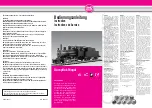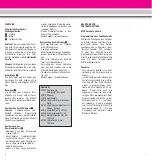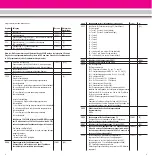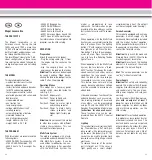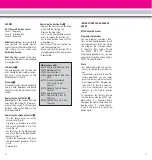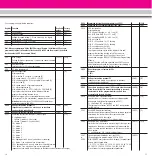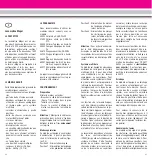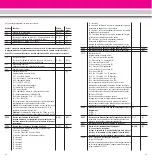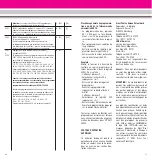
17
16
You can program the following registers:
Register Function
Available Factory
values
pre-set
CV1
Loco address
(00-22)
[3]
CV2
Starting voltage
(0-255)
[5]
voltage for speed setting 1 - if loco starts only at a higher
speed setting, increase value.
CV3
Acceleration (1 = fast, 255 = slow)
(1-255)
[3]
CV4
Braking (1 = fast, 255 = slow)
(1-255)
[3]
Hint: When programming with the 55015 Universal Remote, the following CVs are pro-
grammed by input of the number of the desired CV in CV6 and then input of the desired
function value in CV5 (see example below).
CV5
Max. voltage
(1-255)
[255]
Voltage for highest speed step - if a lower top speed is desired,
decrease value.
CV5
after input of CV6
function value for CV to be programmed
CV6
CV to be programmed
CV29
NMRA configuration
[4]
Bit programming
Bit 1: direction, 0 = normal, 1 = reversed [0]
Bit 2: speed steps, 0 = 14 (LGB), 2 = 28 [0]
Bit 3: analog operation, 0 = not possible, 4 = possible [4]
Bit 4: not used [0]
Bit 5: speed steps, 0 = factory-programmed,
16 = user-programmed [0]
Bit 6: address area, 0 = 0-127 (LGB), 32 = 128-10039 [0]
To program, add the values for the individual Bits and
program the resulting function value.
Hint:
To program a loco to reversed direction of travel
(for example,F7 A-B-A combination), program function value 5.
Attention!
Loco addresses 128-10039 and 28 speed steps
cannot be used with LGB MTS).
CV49
Voltage for function terminal F1
(1-32)
[32]
(depends on loco model, do not change, as functions
can be affected or destroyed)
CV50
Voltage for lighting terminals (see CV49)
(1-32)
[5]
CV51
Command for function terminal F1 (firebox light)
[13]
0 = lighting button 9
1 = button 1 (buttons 2-8 not used)
9 = button 1 (buttons 2-8 used as well)
10 = button 2
11 = button 3
12 = button 4
13 = button 5
14 = button 6
15 = button 7
16 = button 8
64 = lighting button 9 (on only when loco is reversing)
65 = button 1 (on only when loco is reversing)
128 = lighting button 9 (on only when loco is moving forward)
129 = button 1 (on only when loco is moving forward)
(depends on loco model, do not change, as functions can be affected or destroyed)
CV52
Command for front lighting terminal (see CV51)
[128]
CV53
Command for rear lighting terminal (see CV51)
[64]
CV54
LGB configuration
Bit programming
Bit 1: hand-off function, 0 = off, 1 = on [0]
Bit 2: MTS Back-EMF, 0 = off, 2 = on [2]
Bit 3: analog Back-EMF, 0 = off, 4 = on [4]
Bit 4: not used [0]
Bit 5: 0 = F1 constant, 16 = F1 flashing
Bit 6: 0 = F2 constant, 32 = F2 flashing
Bit 7: sound function (0 or 64)
Bit 8: sound function (0 or 128)
To program, add the values for the individual Bits and
program the resulting function value. The values for
Bits 5-8 vary between locos. The values for your loco
can be read using the 55045 MTS PC Decoder Programming
Module.
Hand-off function on: When operating with 55015, you can
adjust direction and speed for two seconds after selecting a
moving loco without causing the loco to stop.
CV55
Reset factory pre-set values for CVs
Program:
6-55->
5-55->
CV56
Voltage for function terminal F2
(1-32)
[5]
(depends on loco model, do not change, as functions
can be affected or destroyed)
CV57
Command for function terminal F2 (see CV51)
[15]
CV58
Pause time (analog operation) (0.5 seconds x function value) (0-255)
[0]
When the polarity of the analog track voltage is reversed,
the loco waits for the programmed time period, then
accelerates in the new direction
CV60
Back-EMF: Max. adjustment factor
(1-255)
[10]
Specifies the max. increase or decrease of voltage applied
during each time interval (programmed in CV61)
1 = small steps, 255 = large steps
The factory pre-set values of CV60 and CV61 are optimized
for LGB motors.
CV61
Back-EMF: Adjustment frequency
(0-255)
[5]
Specifies how often per second the motor voltage is adjusted -
accordingly, the loco will react to curves and grades
immediately or with a short delay
0 = immediate adjustment, 255 = maximum delay
CV62
Back-EMF: Max. Adjustment
(0-255)
[255]
Limits the total adjustment in motor voltage. If there is a very
large load on the motor, the adjustment will not exceed this
value - for more realistic operations, so that locos will slow a
bit on grades.
0 = no adjustment, 255 = maximum adjustment
CV67
Speed steps programmed by user (see CV29):
(0-255)
to
28 speed steps are programmed in CV67 to CV94.
CV94
With LGB MTS, every second value is skipped (14 speed steps).
Factory pre-set speed steps:
7, 9, 11, 13, 16, 20, 24, 28, 32, 36, 42, 48, 54, 60, 68, 76, 84,
92, 102, 112, 124, 136, 152, 168, 188, 208, 230, 255
Pre-set values for user-programmable speed steps:

